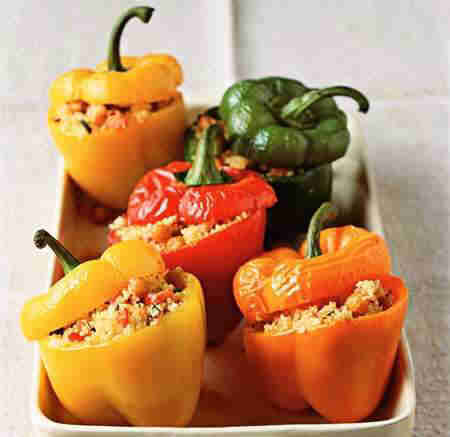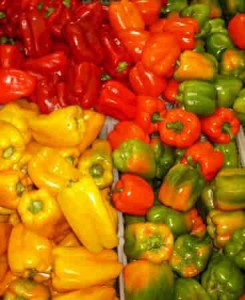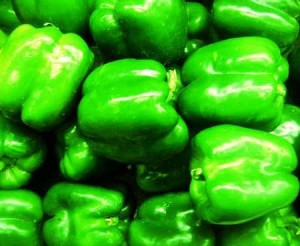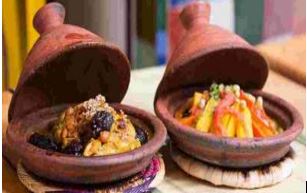Tasty Bell Peppers Gardening in Spain
Bell peppers or sweet pepper is a cultivar group of the species Capsicum annuum (chili pepper).
While the bell pepper is a member of the Capsicum family, it is the only Capsicum that does not produce capsaicin, the chemical causing the strong burning sensation usually associated with the rest of the family.
Bell peppers or sweet peppers
Bell peppers or sweet pepper is a cultivar group of the species Capsicum annuum (chili pepper).
While the bell pepper is a member of the Capsicum family, it is the only Capsicum that does not produce capsaicin, the chemical causing the strong burning sensation usually associated with the rest of the family.
Cultivars of the plant produce fruits in different colours, including red, yellow and orange.
The fruit is also frequently consumed in its unripe form, when the fruit is still green. Green peppers are less sweet and slightly more bitter than red, yellow or orange peppers.
Easy Moroccan cookery courses and street food
Moroccan cookery Local Dishes they abound with subtle spices and intriguing flavour combinations. Learn how to make these classic Moroccan dishes, dishes like Couscous, Tagines. Plus info about Moroccan street food.
Bell peppers
The taste of ripe peppers can vary with growing conditions and post-harvest storage treatment; the sweetest are fruit allowed to ripen fully on the plant in full sunshine, while fruit harvested green and after-ripened in storage are less sweet.
Compared to green peppers, red peppers have more vitamins and nutrients and contain the antioxidant lycopene.
The level of carotene, another antioxidant, is nine times higher in red peppers. Red peppers also have twice the vitamin C content of green peppers.
Orange peppers
contain even more vitamin C and significantly more vitamin A.
They are juicy and sweet, and because they contain less than half the calories of an orange, orange bell peppers are perfect as a refreshing, low-calorie food, both raw or prepared in any dish.
Peppers are native to Mexico, Central America and northern South America.
Pepper seeds were later carried to Spain in 1493 and from there spread to other European, African and Asian countries.
Today, Mexico remains one of the major pepper producers in the world.
Very Popular Summer Crop
Besides tomatoes, peppers are one of the most commonly grown garden crops during the summer. Gardeners are just crazy about peppers.
So, with that in mind, here are a few tips to help you grow, healthy, robust, and flavourful peppers this summer:
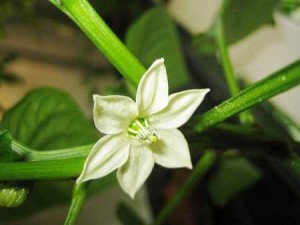
Managing Bell Peppers
- 1. Peppers like evenly moist and evenly warm soil. If moisture levels or temperature levels fluctuate too much you will have problems with root rot and low fruit production. Use a good layer of mulch to help solve this problem.
- Peppers also like well drained soil. If they sit in thick wet soil, their roots will rot. If needed, plant them in containers or raised beds.
- When you buy pepper seedlings in the nursery to transplant, make sure to look for strong stems and healthy, dark green leaves. Also do not buy any plants that already have flowers or fruit on them because they will not produce well for you after you have planted them out.
- Not to beat the point to death, but as soon as you have planted your peppers, spread a thick mulch around the base of the plants, making sure the mulch does not touch any of the plant’s stem.
- Water deeply during dry spells to encourage deep root development, and help with better tasting peppers. Lack of water can produce bitter-tasting fruit.
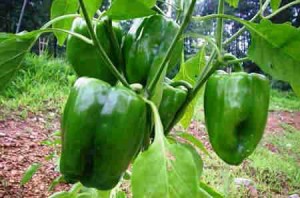
Weeds
- If any weeds pop up, carefully pull them by hand. Do not heavily cultivate peppers because you can damage their roots and they won’t produce or grow as well.
- Very hot days with temperatures over 32° C (90° F), can often cause pepper flowers to drop off and the plants to wilt. To avoid this, plant peppers so that taller garden crops, such as corn, will shade the peppers during the hottest part of the day. If that is not possible, putting shade cloth over them can help.
- Soil Temperatures
- Peppers grow best when the soil temperatures are at least 16° C (60° F).
- Most sweet and hot peppers are at their best when fully mature. That said, in order to keep plants bearing fruit longer, you will have to harvest some peppers before they are fully ripened. That’s OK, they will still taste super.
- Always cut peppers from the plant – do not pull them off. You can damage the stem and plant and slow fruit production.
- Enjoy your peppers – they are good for you!
- Marc Vijverberg
Up close pepper growing Tutorial.
Here we go! An up close tutorial on growing, sturdy healthy productive pepper plants!
Red, Orange, and Yellow Bell Peppers Vegetable Journal:
Hi
This is an invitation to come and have a look at another Groups Facebook page. https://www.facebook.com/groups/1623745237901625/?fref=ts It is called Hints and tips about gardening in Spain. The pitfalls and the joys. Limited advertising is allowed provided it is on subject.
How about a Safari
THIS IS WHERE YOU MIGHT Discover that SPECIAL wildlife and nature holiday on a once in a lifetime Safari Tour in places such as Africa & the Middle East, The Americas & Caribbean, OR Asia & Oceania.
===Find and compare safaris and wildlife tours from 796 organizers worldwide!
Bell Peppers
P95 W 100 Optimised march 10 July 8 H 77 Bell Peppers 9 H 95 BP 14 H 98 Sept 29 H 77 P 98 K 100 F
Spain Info, Urb Marina, San Fulgencio, 03177, Alicante, Spain
Site Disclaimer
Disclaimer: Whilst every effort has been made to provide accurate information, no liability will be accepted for misinterpretation, misrepresentation, errors or omissions - the information provided by our Websites is for use as a guide only and is issued in good faith as information..
All photographs images and FILM material is subject to the understanding that as they are in the public domain they can be used and shared as seen to be appropriate and unless showing a sign that they are covered by copyright law. This also covers Social media operations.
1999---2025
